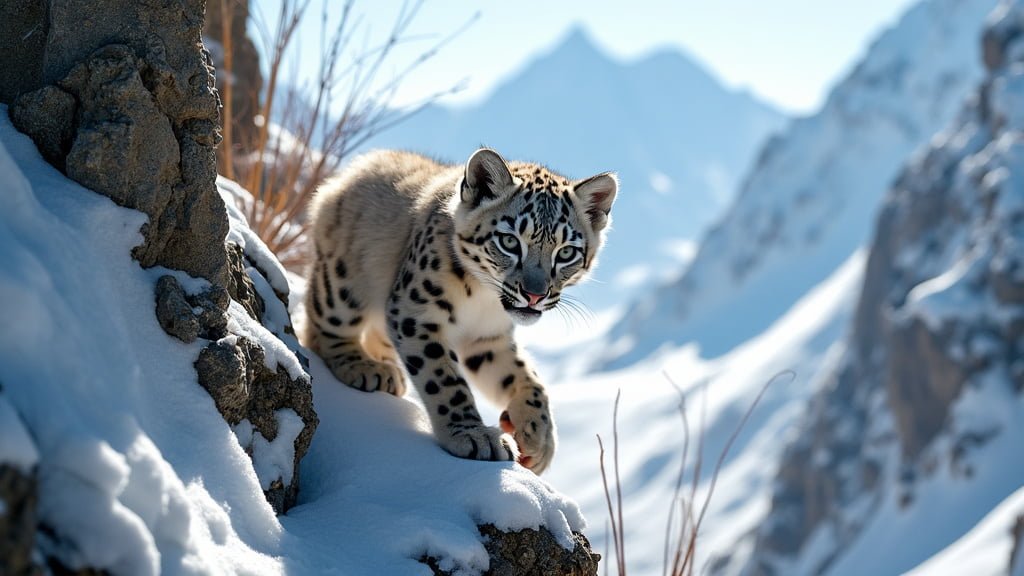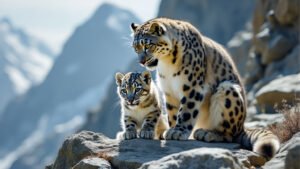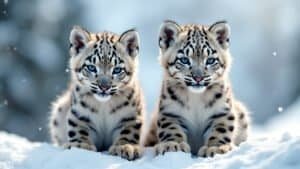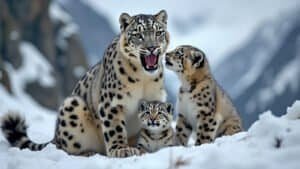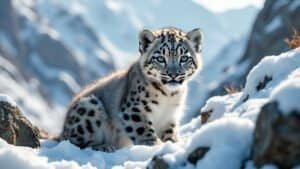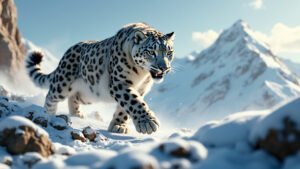Introduction
Snow leopard cubs are born into one of the most challenging environments on Earth, the rugged and cold mountain ranges of Central and South Asia. As these cubs grow, they must adapt to the harsh conditions to survive
From developing essential climbing skills that allow them to navigate steep cliffs to learning complex hunting strategies from their mothers, snow leopard cubs undergo significant physical and behavioral changes
This article will explore the key stages of adaptation in snow leopard cubs, examining how they develop survival skills, the role of the mother in their upbringing, and the physical and behavioral changes they experience as they mature
The Development of Climbing Skills in Snow Leopard Cubs
Snow leopard cubs are born into a world dominated by towering mountains, steep cliffs, and rocky outcrops. Their ability to navigate these treacherous terrains is crucial for survival, and climbing is one of the first skills they must master
This skill is not only essential for moving around their environment but also for hunting and escaping predators. The development of climbing skills in snow leopard cubs is a gradual process that begins shortly after birth and continues into their early years, shaped by both instinct and learned behavior from their mothers
Early Stages of Climbing
In the initial weeks after birth, snow leopard cubs are entirely dependent on their mother and remain within the safety of their den, which is typically located in a secluded, rocky area. At this stage, the cubs are blind and helpless, with limited mobility
It’s only after two to three weeks that their eyes open, and they begin to explore their immediate surroundings. This early exploration is critical as it marks the beginning of their climbing development
Cubs start by clambering over small rocks and boulders, slowly building their strength and coordination. This period of early exploration is characterized by a lot of trial and error, where the cubs learn to balance, grasp, and pull themselves up onto uneven surfaces
Advancements in Agility and Strength
As the cubs grow, usually by the age of 2-3 months, their physical abilities improve significantly. Their muscles strengthen, and they become more coordinated, allowing them to attempt more challenging climbs. By now, they are actively following their mother across more difficult terrains
During this stage, the cubs’ agility and strength are put to the test as they start scaling steeper and more vertical rock faces. These early climbing attempts are crucial for developing the muscle memory and reflexes needed for adult life
Studies have shown that this period is essential for the cubs to learn how to judge distances and land safely after jumps, skills that are vital when pursuing prey or evading danger in the wild
Role of the Environment in Climbing Development
The snow leopard’s environment plays a significant role in shaping the climbing abilities of its cubs. The rugged, mountainous habitats where snow leopards are found, such as the Himalayas and the mountains of Central Asia, are full of natural obstacles that the cubs must learn to navigate
The steep slopes, loose rocks, and high altitudes present a challenging setting that requires precision and strength. The cubs’ repeated exposure to this environment allows them to hone their climbing skills gradually. By the time they are ready to leave their mother, usually around 18-22 months old, snow leopard cubs have become adept climbers, capable of scaling the most challenging terrains in their habitat
Their ability to move with confidence across these landscapes is a testament to the rigorous training and natural adaptations they undergo during their early development
Survival Skills Acquired by Snow Leopard Cubs
Snow leopard cubs face a challenging journey as they grow, learning essential survival skills necessary for life in the harsh mountain environments they inhabit. These skills are crucial not only for their day-to-day survival but also for their eventual independence from their mother
The process of acquiring these skills begins early in their development and is primarily guided by their mother, who teaches them how to hunt, camouflage, and navigate the treacherous terrain
Learning to Hunt
Hunting is arguably the most critical survival skill that snow leopard cubs must learn. Their mother plays a pivotal role in this learning process, introducing the cubs to prey animals and demonstrating hunting techniques
Initially, cubs observe their mother’s hunting behavior, learning how to stalk, ambush, and deliver a fatal bite. As they grow older, they begin to participate in the hunt, starting with easier prey like small rodents or birds before moving on to larger animals such as blue sheep and ibex
According to research by McCarthy and Chapron (2003), cubs begin hunting with their mother at around six months old, though they do not become proficient hunters until they are about 18 months old
The hunting skills they acquire during this period are crucial for their survival once they become independent, as snow leopards rely heavily on their ability to secure food in the sparse mountainous regions they inhabit
Developing Camouflage Techniques
Another vital skill that snow leopard cubs must master is the ability to camouflage themselves within their environment. The mountainous regions where snow leopards live are characterized by rocky outcrops, cliffs, and snowy expanses, all of which provide natural cover
The cubs’ thick fur, which is already marked with rosettes and spots, offers excellent camouflage against these backgrounds. However, knowing how to use their environment to remain unseen is a learned behavior. The mother teaches the cubs how to stay low and blend in with the rocks or snow, minimizing their movement when potential prey or predators are nearby
This skill not only aids in hunting but also in avoiding detection by larger predators or human threats. Studies have shown that effective camouflage is crucial for a snow leopard’s hunting success, as it allows them to get close enough to their prey before launching an attack
Adapting to the Mountainous Terrain
Navigating the rugged, mountainous terrain is a skill that snow leopard cubs must develop early in life. This skill is closely tied to their climbing abilities but also includes understanding the geography of their environment and knowing how to move efficiently across it
The cubs learn from their mother how to follow game trails, cross rivers, and avoid dangerous areas like loose scree slopes or areas prone to avalanches. They also learn to recognize the signs of changing weather, which is essential for survival in the mountains, where conditions can deteriorate rapidly
By the time they reach adolescence, snow leopard cubs have developed a keen sense of their surroundings, enabling them to navigate and survive in one of the most challenging environments on Earth
The Role of the Mother in Cub Development
The mother snow leopard plays a crucial role in the survival and development of her cubs. From the moment they are born, she is their primary protector, teacher, and provider. The bond between mother and cubs is essential, as it ensures that the young leopards learn the necessary skills to survive in their harsh environment
The mother’s guidance during the early months of life is vital for the cubs’ physical and behavioral development, influencing their ability to hunt, navigate terrain, and avoid dangers
Teaching Hunting Strategies
One of the mother’s most critical roles is teaching her cubs how to hunt. Hunting is a complex skill that requires patience, precision, and practice. The mother introduces her cubs to the art of hunting gradually
Initially, she will bring back small prey to the den, allowing the cubs to familiarize themselves with the scent and taste of meat. As the cubs grow, she takes them on hunting expeditions, where they watch and learn from her techniques
These trips are often the cubs’ first exposure to the challenges of stalking prey in the wild. The mother demonstrates how to approach prey stealthily, position herself for an ambush, and deliver a quick, lethal strike
Over time, the cubs begin to mimic these actions, starting with smaller and less challenging prey before attempting larger animals like wild sheep and goats. By observing and practicing alongside their mother, cubs develop the skills they will need to hunt independently
Protection and Survival Training
Beyond teaching her cubs how to hunt, the mother is also responsible for their protection and overall survival training. The mountainous environment is fraught with dangers, including predators, avalanches, and severe weather
The mother snow leopard is constantly vigilant, using her experience to shield her cubs from harm. She teaches them how to recognize and avoid threats, such as when to take cover from a potential avalanche or how to avoid areas frequented by wolves or humans. During the early months, she keeps the cubs close, often hiding them in dens or secluded rocky areas while she hunts
As they grow, she gradually exposes them to more of the environment’s dangers, allowing them to develop the instincts and awareness necessary for survival. The mother’s role as a protector is critical, especially during the cubs’ first year, when they are most vulnerable
Social Behaviors Passed Down
In addition to survival skills, the mother also passes down crucial social behaviors that help the cubs integrate into the snow leopard population. Snow leopards are generally solitary animals, but they do have a social structure and communicate through various vocalizations, scents, and body language
The mother teaches her cubs how to use these communication methods, including how to mark territory with scent, vocalize for different situations (such as calling for mates or warning intruders), and use body language to assert dominance or show submission
These social behaviors are essential for the cubs as they mature and establish their own territories. Understanding and practicing these behaviors increases their chances of successfully navigating interactions with other snow leopards and avoiding unnecessary conflicts
Physical and Behavioral Changes as Cubs Grow
As snow leopard cubs mature, they undergo significant physical and behavioral changes that are crucial for their adaptation to the harsh mountainous environments they inhabit
These changes help them transition from dependent cubs to independent, capable predators. Understanding these transformations provides insight into how snow leopards have evolved to survive in some of the most challenging terrains on Earth
Changes in Physical Traits
One of the most noticeable changes in snow leopard cubs as they grow is the development of their physical traits. At birth, snow leopard cubs are small and covered in a thick layer of soft fur. As they mature, this fur becomes denser and more suited to the cold, harsh climates of their environment
Their fur, marked with distinctive rosettes and spots, provides excellent camouflage against the rocky, snowy landscapes they call home. By the time they reach adolescence, their paws have also grown larger, helping them walk on snow more efficiently by distributing their weight over a larger area. This adaptation is crucial for moving through deep snow without sinking
Additionally, the cubs’ muscles develop significantly, giving them the strength needed for hunting and climbing. Their tails, which are used for balance and warmth, also become thicker and longer, further aiding their agility in navigating the steep and uneven terrain of their mountainous habitat
Evolving Dietary Needs
As snow leopard cubs grow, their dietary needs evolve significantly. In the early weeks of life, they rely entirely on their mother’s milk for nutrition. This milk provides the essential nutrients required for their rapid growth during the first few months
However, as the cubs begin to wean, usually around two to three months of age, their diet starts to include solid food. Initially, this food consists of small prey that their mother brings to the den. As the cubs’ digestive systems mature and their hunting skills develop, they gradually shift to a diet that mirrors that of an adult snow leopard, which includes larger prey such as blue sheep, ibex, and other mountain ungulates
This transition is critical, as it not only prepares their bodies for the demands of adulthood but also teaches them the skills necessary to hunt and secure their own food in the wild
Behavioral Adaptations to the Harsh Climate
The behavioral changes in snow leopard cubs as they grow are largely influenced by the need to adapt to their harsh, high-altitude environment. As they mature, cubs learn to conserve energy during times when food is scarce, a behavior observed in many large predators living in extreme climates
This includes reducing unnecessary movement and sleeping during the day to conserve warmth and energy. They also become more adept at using their environment for shelter, learning to seek out caves, overhangs, or dense vegetation to protect themselves from the wind and cold. Social behaviors also evolve; while young cubs are highly dependent on their mother, older cubs begin to exhibit more independence, spending time alone and starting to establish their own territory
This shift is crucial for their eventual separation from their mother and for surviving as solitary adults. By the time they are ready to leave their mother, usually around 18-22 months old, they have developed the physical and behavioral traits necessary to thrive in their challenging environment
Conclusion
Snow leopard cubs face a challenging journey as they adapt to their harsh mountainous environment. From their early stages of climbing, where they develop the agility and strength necessary to navigate steep terrains, to the critical survival skills they acquire under the guidance of their mother, these young leopards undergo significant physical and behavioral changes
The mother’s role is vital in teaching the cubs how to hunt, protect themselves, and navigate their surroundings, ensuring they grow into capable, independent adults. As the cubs mature, their physical traits, such as thicker fur and larger paws, evolve to meet the demands of their environment, while their dietary and behavioral adaptations equip them to survive in one of the world’s most challenging habitats
By the time they are ready to leave their mother, these snow leopards are well-prepared to face the rigors of life in the wild, embodying the resilience and adaptability of their species
